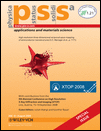Recent developments in tomographic small-angle X-ray scattering
Abstract
Small-angle X-ray scattering (SAXS) has become a standard tool for the investigation of nano-structured materials with applications in many fields of science. Scanning tomography adds three-dimensional information to the method. We investigate the validity of the tomographic model in SAXS tomography. We identify the requirement of local rotational invariance of the SAXS cross section and discuss the role of coherence in the framework of SAXS tomography. A tomography experiment performed on nanoporous glass is described as a practical example of the method.
SAXS tomography reveals the density and nanostructure on a virtual section through a piece of nanoporous sodium borosilicate glass.





